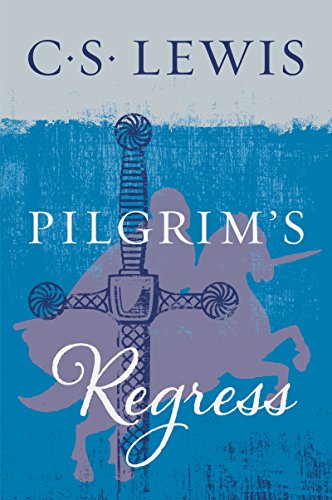The Long View: Where C. S. Lewis and Hermann Hesse Meet

It has been twenty years since I last read The Pilgrim's Regress, and I've never gotten around to The Journey to the East. Perhaps it is about time.
Where C.S. Lewis & Hermann Hesse Meet
By John J. Reilly
Could I really be the first reader to notice that C.S. Lewis and Hermann Hesse wrote almost the same book at almost the same time? Surely their audiences overlap so much that someone else should have remarked on the coincidence before now. It's 2004, for God's sake.
The books in question are Lewis's The Pilgrim's Regress: An Allegorical Apology for Christianity Reason and Romanticism, which was first published in 1933, and Hesse's The Journey to the East, which was published in 1932 under the title Die Morgenlandfahrt. The Hesse book has been available in English since 1956. Both books are quite short; the Hesse book is really just a short story.
Both these stories are about a quest for the transcendent. In Hesse's Journey, many people are engaged in a movement to promote the quest, under the general oversight of an immemorially ancient League. The League has definite, secret goals of its own, but each pilgrim has a private goal, too:
“For example, one of them was a treasure-seeker and he thought of nothing but of winning a great treasure which he called 'Tao.' Still another had conceived the idea of capturing a certain snake to which he attributed magical powers and which he called Kundalini. My own journey and life-goal, which had colored my dreams since my late boyhood, was to see the beautiful Princess Fatima and, if possible, to win her love.”
In Lewis's Regress, the quest follows a vision of an Island. The details of sight and sound connected with this vision are never certain, but the aesthetic effect is overwhelming:
“While he strained to grasp it, there came to him from beyond the wood a sweetness and a pang so piercing that instantly he forgot his father's house, and his mother, and the fear of the Landlord and the burden of the rules.”
Both authors take care to mention a recent, terrible war (the First World War, from different sides), but neither story connects with ordinary history. Lewis's book is in many ways an homage to John Bunyan's Pilgrim's Progress, though it is immeasurably wittier than Bunyan's book. Lewis's protagonist, John, crosses a symbolical landscape from east to west, ascertaining among many adventures that his Island is not to be found in Romantic poetry, or sex, or transcendental idealism, or for that matter in common sense or politics. Later, he recrosses the land from west to east, and finds that the transcendent he had sought was always located in the mountains to the east of his home. The League's “journey to the east” is little concerned with making geographical progress in that direction. In fact, the companies of League pilgrims sometimes wander into other times, often under the leadership of historical figures. Hesse's protagonist, H H (or, to his friends, H), is aware from the outset that the League is “going home,” to the origin, but without prejudice to his private enthusiasm.
Both John and H despair of their quests. H's company dissolves in disarray when the servant Leo absconds with certain objects that the members of the company decide are essential. H later believes that the League has dissolved, and that its quest was just a metaphor or illusion. John comes to believe that the direct experience of his Island is incompatible with life itself. Both then undergo a test to regain the vision. H is tried by the League for attempting to write its history. John undergoes an extreme form of baptism that involves swimming into an underground channel. H, having regained his faith as a League member, is admitted to the second novitiate. John sees the Island when he reaches the farthest west of the land, and knows that he is seeing the familiar mountains of his youth from the other side.
These climaxes may be structurally equivalent, but they are substantially dissimilar. Although Hesse stresses the importance that the League places on prayer and respect for every kind of piety, no one would consider The Journey to the East to be a story of conversion. It's not even a tale of enlightenment; the closest we get to a revelation is the suggestion that characters may be more real than their authors. Pilgrim's Regress, in contrast, is frankly about a search for beauty that results in the discovery of God. Nonetheless, it is clear, to me at least, that Lewis and Hesse are dealing with the same emotion. Lewis uses the term “joy” in his autobiography, but there is also the German word “Sehnsucht.” Better still might be the Welsh “hiraeth.” That term can cover a lot of semantic ground: yearning, grief, homesickness, but often with a transcendental flavor. The “home” in the homesickness of the hiraeth might not be anyplace you have ever yet been.
C.S. Lewis never claimed to be a theologian; writing as an apologist, he often cautioned his readers to take what he says with a grain of salt. Still, anyone familiar with his writings knows how important “joy” was to him. We must ask ourselves: if Hesse can follow the same scent that Lewis did and not arrive at an orthodox Christian conclusion, then was Lewis mistaken in thinking that “joy” was a call from God? In answer to that question, I think, Hesse would by no means deny that this joy is a call from God. Hesse seems to assume the eschatological unity of religions, which is the hypothesis that religions with quite different claims about God and history can nonetheless be united by their common transcendent object. Lewis himself was not wholly out of sympathy with that position, but only in the sense of allowing that God is unlikely to make flawless orthodoxy a condition of salvation.
All we can say for sure is that The Journey to the East ends on a far more enigmatic note than does The Pilgrim's Regress. H does not seem likely to actually arrive at the ultimate east anytime soon. Whether Hesse ever did is another question.
Copyright © 2004 by John J. Reilly

The Pilgrim's Regress By C. S. Lewis



Comments ()